Polyethylene pipes for a gas pipeline: types and specifics of laying pipelines made of polyethylene
Previously, pipes made of cast iron, steel, copper were used in industrial and domestic communications. With the advent of polymers not inferior to metal products in terms of strength, wear resistance and inertness to chemicals, the pipe material began to be made of polypropylene, polyethylene, polyvinyl chloride, polybutylene, etc.
Polyethylene pipes for the gas pipeline have proven themselves well - practical, flexible, lightweight, significantly facilitating transportation and installation. If you decide to gasify a private house, then it will not be out of place to find out in more detail about the technical characteristics, conditions and methods of installing polyethylene pipes.
The content of the article:
PND pipes for the gas pipeline
Low-pressure polyethylene is used not only for the manufacture of gas pipeline elements. It is also used for other communications - water supply, sewage, protective technical pipelines. Types of pipes differ in composition, characteristics, marking.
Let us dwell on gas transportation products, the production of which is subject to the requirements GOST R 50838-2009 (outdated edition - GOST R 50838-95).
Types and sizes
Polymeric pressure pipes for gas can consist only of polyethylene or reinforced with additional layers.
Thus, there are three types:
- polyethylene, including those marked with yellow stripes;
- polyethylene with coextrusion layers located inside or outside;
- polyethylene with a thermoplastic protective shell, which must be removed before installation.
All types of pipe material are intended for the transportation of various gases that meet the standards of GOST 5542 and are used as raw materials or fuel for industrial and domestic needs. Adopted restrictions for the use of pipelines: max slave. pressure - 1.2 MPa, max slave. temperature - / + 40 ° С.
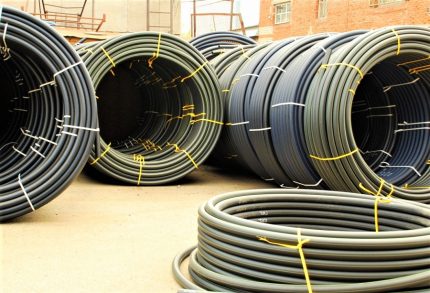
Industrial products are supplied in segments of 5-24 m, multiples of 0.25 m, but more often of medium length, convenient for transportation by special equipment - for example, 13 m. Winding a thin pipe in a bay assumes different lengths, but more often you can see skeins of 200, 500, 700 m. It is possible to manufacture products and other lengths, but only by agreement with customers.
Depending on the wall thickness and slave. pipe pressure is divided into two types:
- PE-80. Wall thickness - 2-3 mm, slave. pressure - 3-6 MPa; suitable for gas pipelines and water pipes;
- PE-100. Wall thickness - 3.5 mm, slave. pressure - 8-12 MPa; This is an improved version of PE 80, characterized by heat resistance and increased density.
PE (options - PE, PE) in the name is polyethylene, the numbers 80 and 100 are polyethylene brands.
From the point of view of economic feasibility, the PE 100 brand is used when installing a high-pressure gas pipeline or in special cases - for example, for reconstruction of an old worn-out pipeline or construction of experimental branches with a pressure of 0.6 MPa and above.
Specifications and Labeling
Factory-made polyethylene pipes are subject to the requirements listed in GOST R 50838-2009. Among them are recommendations for appearance and technical properties.
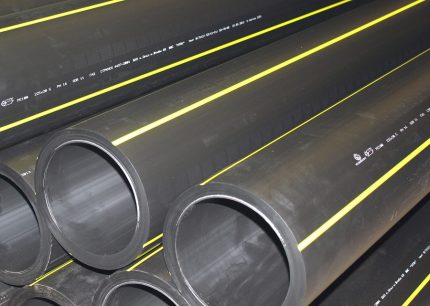
In terms of color, the possibility of variability:
- PE 80 - yellow;
- PE 100 - yellow, orange, black with yellow / orange stripes distributed evenly.
The document spells out norms and characteristics such as resistance at constant internal pressure, elongation at break, resistance to crack propagation, thermal stability, and weldability.

Marking should not affect the quality of the material, that is, provoke cracks, swelling, etc.
Letters and numbers should be easy to read, legible and understandable. Mandatory include:
- manufacturer's trademark or name;
- pipe symbol
- production date;
- nominal diameter / wall thickness;
- appointment;
- GOST.
The rest of the data - the name of the country, the batch number, etc. - is applied at will.
For example, we will analyze one of the samples:
Sphere LLC PE 80 SDR 11 - 150x10.5 GAS GOST R 50838-2009
- Sphere LLC - manufacturer
- PE-80 - type of polyethylene pipe
- SDR 11 - standard size ratio
- 150 - diameter
- 10.5 - wall thickness
- GAS - appointment
- GOST R 50838-2009 - regulatory document
By marking it is easy to determine whether the pipes are suitable for domestic or industrial use, whether they are suitable for purpose and diameter.
Advantages and disadvantages of polyethylene
Due to the advantages of polyethylene, it is used to transport such a dangerous type of fuel as natural gas.
The main advantages include such qualities as:
- Electrical insulation properties. Polyethylene is a full-fledged dielectric, it does not conduct electric currents. Installation does not require grounding.
- Resistance to aggressive chemicalsthat may be contained in the soil or in the workplace.
- No corrosion, the possibility of use in a humid environment.
- Plasticdue to which the pipeline is protected from soil movements, expansion during freezing, water hammer.
- Acoustic vibration passivity.
The degree of wear resistance is quite large - manufacturers of modern PE pipes for gas give a guarantee of 30 to 50 years.
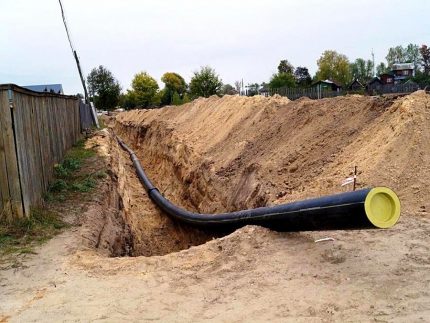
The disadvantages include such a property of polyethylene as photodegradation. This means that the material quickly ages and crumbles under the influence of ultraviolet radiation. In order to somehow improve the resistance of polyethylene to solar radiation, black pigment is added to the material as a stabilizing agent.
Among the other disadvantages - a small range of operating temperatures of the transported substance, oxygen permeability, the dependence of technical characteristics on external temperature.
Due to these shortcomings, gas pipelines made of polyethylene pipes are used only in the ground, metal analogues are installed in open areas.
Installation of polyethylene gas pipes
It is forbidden to independently install the gas pipeline to a private house or industrial facility. This should be done by an organization that has a license and the license justified by the license to carry out this type of work. In the future, it also carries out maintenance - it performs inspection, testing or repair work.
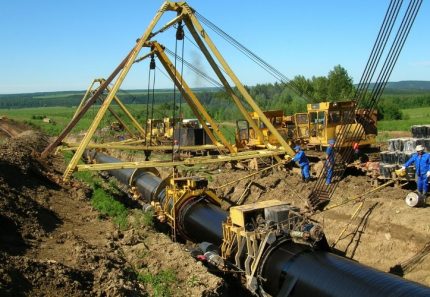
First, they obtain permission to carry out construction work, create a package of design and estimate documentation and build a geodetic center axis. Then they carry out preparation, which includes route planning, earthwork, transportation and pipe laying, installation welding tool. And only then they begin directly to the installation work - laying and welding of pipes.
Overview of pipe connection methods
Polyethylene is different in that when heated it changes its properties and melts. This quality is used to create permanent connections of the gas pipeline - that is, for pipe welding.
Two welding methods are distinguished:
- butt, without the use of shaped elements;
- electrofusionusing electrical resistor fittings.
The first method is used for industrial purposes, for welding large-diameter pipes, the second - to create household gas branches from the central highway.
If a detachable connection is necessary, then the third method is used - compression. The ends of the pipes are connected by crimp fittings, which, if necessary, can be removed or replaced.

First, consider how to perform welding. Preparatory work takes place according to one plan:
- Selection and verification of materials for installation and tools. Heaters, scrapers and trimming tools are cleaned, remove the remaining polyethylene and dust, wipe with a solvent. Friction surfaces and components lubricate. Suitable in diameter liners and clamps.
- Welding selection. Tools program, enter certain parameters into the memory of the heating equipment.
- Site preparation. The ends of the pipes are cleaned of sand, adhering clay, dust, wiped. The free ends are covered with plugs. The oxidized ends are cleaned with scrapers.
- Fixing and centering pipes. Before welding, it is necessary to eliminate ovality, so the ends of the pipes are centered, and then fixed in the right position - exactly opposite each other.
- End processing. Chips with a thickness of 0.1-0.3 mm are removed from the surface at the ends. The gap between the segments connected end-to-end should be no more than 0.3 mm. After cleaning, it is necessary to weld to prevent contamination.
After preparatory work, welding is performed.
Butt weld joint occurs due to the "fusion" of the melted ends. Melting can be achieved using a heating tool with a disk work element.
In the welding process, it is important to take into account criteria such as temperature and time of reflow, pressure force of the ends, duration of the upsetting period, pressure during upsetting and cooling time.
Work order:
Signs of a reliable seam are a uniform homogeneous scar, the inability to disconnect the pipe using force. Welding by melting is considered to be very durable and does not require additional sealing measures.
The second way is electrofusion - characterized by the presence of connecting elements - couplings, adapters, bends, tees. A metal spiral is fixed on the inner surface of the fittings, which is heated by electric current and melts the polyethylene. As a result, the fittings “merge” with the pipes, forming one-piece joints.
When choosing elements for connecting pipes for gas from polyethylene, as well as during the procedure, it is important to take into account parameters such as voltage, welding and cooling times.
The technology is simpler than butt welding, and occurs in the following order:
Modern welding machines are equipped with a control panel with a display.The procedure is performed according to the program selected depending on the type of pipe.
Detachable connections when the gas pipeline is used extremely rarely. Fittings are also used for this, but they are fixed mechanically, without heating.
The connecting elements consist of two parts - a compression ring and a housing. Twisting the threaded parts results in a strong but unstable connection. If additional reliability is needed, the parts of the fitting are twisted with bolts and nuts.
Rules for the arrangement of the PND gas pipeline
During the installation and operation of polyethylene pipes, many rules should be followed that ensure both the health of the gas pipeline and equipment, as well as the safety of users.
There are many bans on laying highways. For example, it is impossible to conduct gas with the help of HDPE pipes in rocky and heavily-soiled soils, as well as in soils of the 2nd type of subsidence. If the area is prone to earthquakes and seismicity above 6 points is observed, it is necessary to use other material for laying communications.
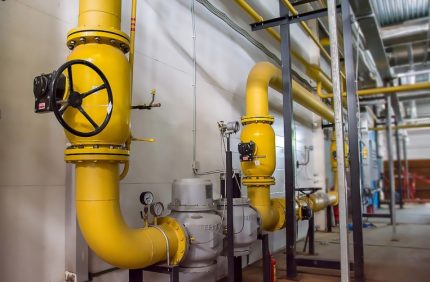
If it is allowed to use HDPE pipes, a number of conditions must be met. For example, on steep slopes, it is necessary to protect the gas pipeline from possible erosion of trenches and take additional measures to strengthen them.
When crossing underground sewers or channels, sewer or power lines, wells, polyethylene pipes are enclosed in metal cases. The distance from the surface of the gas pipeline to the inner wall of the case is at least 10 cm.
Two or more gas pipelines can be placed in one trench, but with access to each branch for maintenance or repair.
In the northern regions, where the temperature drops below -40 ° C, the installation depth increases to 2.0-3.2 m.
On how to lay a gas pipeline in a case with its entry into a gasified house next article, which we advise all owners of suburban property to read.
Conclusions and useful video on the topic
Electrofusion welding rules:
About the features of butt welding:
How does the welding machine for HDPE pipes:
The use of polyethylene pipes for the gasification of industrial and residential facilities has become a tradition.
HDPE is a durable and reliable material that does not cause concern. But the installation of the gas pipeline should be done exclusively by gas network installers with experience and knowledge of polyethylene welding technology.
Please leave comments in the block form below, post a photo on the topic of the article, ask questions. Share your own experience in building a polyethylene gas pipeline. It is possible that the information and recommendations you submitted will be useful to site visitors.

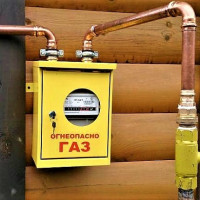 Copper pipes for gas: specifics and norms for laying a copper pipeline
Copper pipes for gas: specifics and norms for laying a copper pipeline 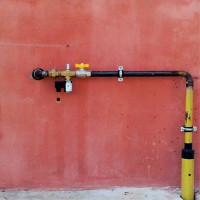 Laying a gas pipeline in a case through a wall: the specifics of a device for introducing a pipe for gas into a house
Laying a gas pipeline in a case through a wall: the specifics of a device for introducing a pipe for gas into a house 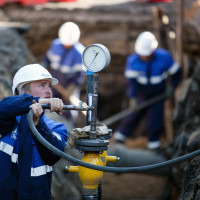 Gas line pressure testing: how are control tightness tests carried out
Gas line pressure testing: how are control tightness tests carried out 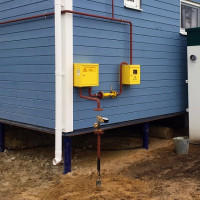 Gas pipeline exit from the ground: requirements and features of the arrangement of the exit node
Gas pipeline exit from the ground: requirements and features of the arrangement of the exit node 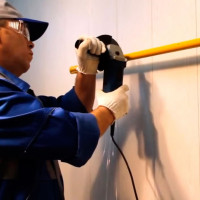 Gas pipes are changed in the house: the nuances of replacing gas pipes in an apartment building
Gas pipes are changed in the house: the nuances of replacing gas pipes in an apartment building 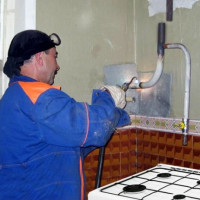 How to transfer a gas pipe in an apartment: transfer rules and location tips
How to transfer a gas pipe in an apartment: transfer rules and location tips  How much does it cost to connect gas to a private house: the price of organizing gas supply
How much does it cost to connect gas to a private house: the price of organizing gas supply  The best washing machines with dryer: model rating and customer tips
The best washing machines with dryer: model rating and customer tips  What is the color temperature of light and the nuances of choosing the temperature of the lamps to suit your needs
What is the color temperature of light and the nuances of choosing the temperature of the lamps to suit your needs  Replacement of a geyser in an apartment: replacement paperwork + basic norms and requirements
Replacement of a geyser in an apartment: replacement paperwork + basic norms and requirements